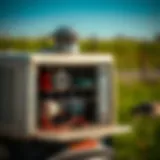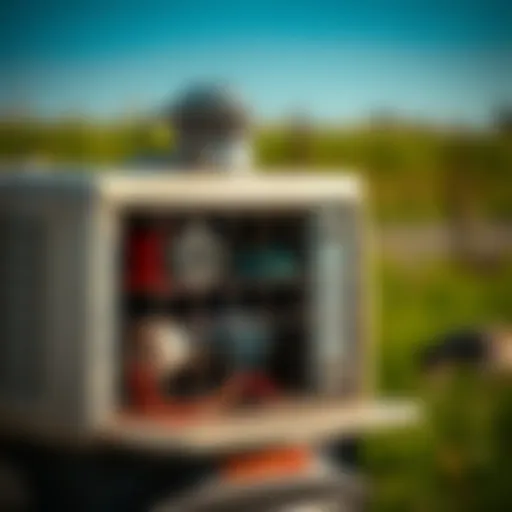Exploring Blue Ring Landscaping: Principles & Benefits
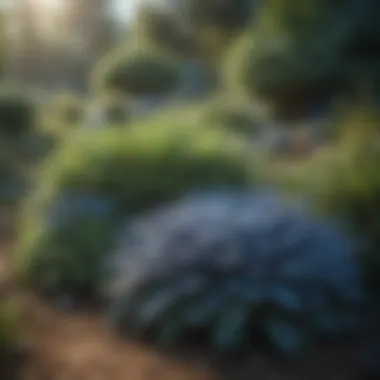

Intro
Blue ring landscaping is an emerging concept that focuses on creating sustainable and aesthetically pleasing outdoor spaces. This innovative approach emphasizes the integration of native plants, efficient irrigation techniques, and unique design principles. A blue ring landscape not only serves as an attractive addition to any environment, but it also promotes ecological benefits and enhances biodiversity.
Understanding the core principles of blue ring landscaping is essential for both professionals and enthusiasts in the gardening and landscaping field. It goes beyond simple garden design; it involves creating environments that are both functional and meaningful. By learning about the principles, techniques, and benefits of this landscaping strategy, one can make informed decisions that contribute to sustainable practices in horticulture and urban planning.
Key Concepts and Terminology
Basic Definitions
Blue ring landscaping is characterized by the strategic use of blue-hued plants and water features. These elements play a crucial role in creating visual harmony and enhancing the sensory experience of outdoor spaces. The term "blue ring" can also refer to the circular arrangement of plants that emulate the natural contours of aquatic environments, promoting a sense of tranquility.
Historical Context
Historically, landscaping has always been about adapting to the local ecosystem. In recent decades, there has been a shift toward more ecologically aware practices. Blue ring landscaping fits into this narrative by combining traditional design elements with modern environmental sustainability principles. This progression toward sustainable landscapes reflects a growing awareness of environmental issues and the need for biodiversity preservation.
Recent Innovations and Trends
Technological Advancements
New technologies are changing the landscaping industry. Automated irrigation systems, for instance, allow for precision watering, minimizing water waste. Furthermore, advancements in landscaping design software aid landscape architects in visualizing their projects. Virtual reality tools can enhance presentations, ensuring clients understand the planned outcomes before implementation.
Sustainable Practices
Sustainable practices are central to blue ring landscaping. These include the selection of native plants, which require less water and maintenance. Additionally, using organic fertilizers and avoiding chemical pesticides contribute to healthier ecosystems. Composting and mulching further enhance soil quality and promote plant growth.
Practical Applications and Techniques
Step-by-step Guides
Creating a blue ring landscape involves careful planning and execution. Here are some essential steps:
- Assess the site conditions, including soil type, sunlight exposure, and existing vegetation.
- Determine the goals for your landscape. Consider factors like aesthetics, functionality, and maintenance.
- Select appropriate blue-hued plants. Plants like Blue Star Juniper and Blue False Indigo are ideal choices for their color and resilience.
- Design the layout, paying attention to plant spacing and water features.
- Install necessary irrigation systems, ensuring efficiency and sustainability.
- Regularly maintain and monitor the landscape for adaptive management.
Case Studies
Examining successful blue ring landscaping projects can provide valuable insights. For instance, the High Line park in New York City integrates native species and design elements to create a vibrant urban habitat. This case exemplifies how blue ring principles can enhance the ecological and aesthetic value of public spaces.
"Creating landscapes that prioritize ecological health is not just a trend; it is a necessary evolution for responsible land stewardship."
By understanding and applying these concepts, individuals and professionals can cultivate beautiful, sustainable landscapes that resonate with both nature and community needs.
Preamble to Blue Ring Landscaping
The topic of blue ring landscaping represents a significant advancement in modern horticultural practices and urban ecology. As urban areas expand, the integration of natural elements in landscapes becomes crucial. Blue ring landscaping achieves this by creating harmonious environments that not only appeal visually but are also sustainable. Understanding the core principles and practices of blue ring landscaping is essential for both professional landscapers and gardening enthusiasts. By embracing this methodology, individuals can foster landscapes that promote ecological balance while enhancing the aesthetic quality of their surroundings.
Definition and Concept
Blue ring landscaping primarily emphasizes the use of circular or ring-shaped garden designs, often utilizing blue plant elements. This concept integrates various shades of blue, encouraged by specific plant selections, to create an inviting, tranquil environment. Blue plants, such as bluebells or delphiniums, are selected not just for their color but for their adaptability and low maintenance. The rings or circular patterns in these landscapes often symbolize continuity and unity, reflecting a cohesive approach to garden design.
Historical Context
The idea of creating circular gardens is not new. Cultures throughout history have valued circularity in design, often seen in traditional Japanese gardens. However, blue ring landscaping, as a contemporary practice, emerged from the need for sustainable landscaping solutions. As cities grew, the necessity for eco-friendly practices became pressing. Early adopters recognized the advantages of incorporating blue themes into landscaping, finding that these designs foster not only beauty but biodiversity. This method has evolved, influencing modern landscaping practices by encouraging the integration of local flora and innovative design techniques that respect the environment.
"Blue ring landscaping innovatively combines aesthetics with sustainability, setting a precedent for future gardening practices."
The rise of ecological awareness and community gardening movements further pushed blue ring landscaping into the forefront of landscaping practices. As more people began to appreciate the relationship between nature and urban spaces, the emphasis on creating inviting and sustainable blue landscapes became more pronounced. By drawing from historical insights and modern techniques, blue ring landscaping stands as a comprehensive approach to creating vibrant and ecologically sound landscapes.
The Importance of Landscaping Aesthetics
Landscaping aesthetics plays a vital role in shaping not only the physical appearance of spaces but also the experience of those who interact with them. A well-designed landscape can transform an ordinary area into a visually appealing sanctuary. This aspect is critical when considering blue ring landscaping, which emphasizes harmony, beauty, and ecological balance. The aesthetic appeal of landscapes is not an arbitrary concept; it is grounded in principles that enhance both visual pleasure and the environment's functionality.
The benefits of landscaping aesthetics extend beyond surface-level appearance. Here are some reasons why it matters:
- Enhancement of Property Value: Attractive landscapes can significantly increase the market value of residential and commercial properties. Prospective buyers often regard well-maintained gardens and landscapes as indicators of overall property quality.
- Community Satisfaction: Landscapes that are thoughtfully designed contribute to community pride. Attractive public spaces invite residents and visitors alike, fostering social interaction and well-being.
- Sustainable Design: Aesthetic considerations can promote sustainable practices in landscaping. By choosing native plants and environmentally friendly materials, landscapes can be both beautiful and sustainable.
A focus on aesthetics in blue ring landscaping can bridge the gap between nature and structured design, reinforcing how interconnected beauty and functionality can work together in creating harmonious environments.
Visual Appeal and Harmony
Visual appeal is a fundamental aspect of successful landscaping. In blue ring landscaping, it involves the careful arrangement of colors, patterns, and textures. This approach addresses how plants and landscape elements interact, creating a cohesive and pleasing visual outcome. The use of complementary colors and well-structured layouts can enhance the viewer’s experience, making the environment feel balanced and inviting.
- Color Coordination: The effective application of color theory is essential. Different hues can evoke emotions and set the mood in outdoor settings.
- Texture Variation: Utilization of plants with varying leaf shapes and bark textures adds depth. This diversity captivates the eye and encourages exploration of the space.
- Scale and Proportion: The ratio of plants and features affects how individuals perceive the area. Bringing in larger plants alongside smaller groundcovers creates layers, adding interest and dynamics to the landscape overall.
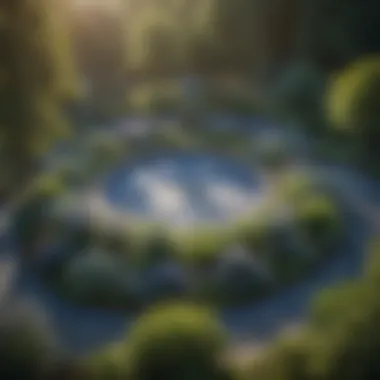

In blue ring landscaping, achieving balance is vital. A harmonious design integrates vibrant colors and varied textures, ensuring that all elements enhance each other rather than compete for attention.
Psychological and Emotional Impact
Landscaping goes beyond aesthetics; it can deeply affect our psychology and emotions. Engaging with well-designed landscapes not only appeals to our senses but can also improve mental health. Research indicates that green spaces contribute to reduced stress, anxiety, and even depression.
- Stress Reduction: Natural environments have a calming influence. Interaction with blue ring landscapes can restore focus and provide relief from everyday stressors.
- Increased Social Interaction: Spaces that are inviting tend to encourage socialization. Well-maintained landscapes become gathering places, facilitating community engagement.
- Cognitive Benefits: Exposure to nature can enhance cognitive function and creativity. The soothing visual aspects of blue ring landscaping stimulate mental processing positively.
Design Principles of Blue Ring Landscaping
The design principles of blue ring landscaping form the backbone of any successful implementations. These principles encompass methods and practices that not only enhance aesthetic appeal but also ensure harmony with the environment. Understanding the nuances in design can lead to profitable outcomes for both the landscaper and the ecosystem. This section will explore critical aspects such as color selection, spatial arrangements, and the meaningful integration of natural elements.
Color Theory Application
Color is more than just a visual treat; it has profound implications on perception and mood. In blue ring landscaping, color theory plays a pivotal role.
- Emotional Response: Different colors evoke specific feelings. For example, shades of blue are known to create a calming effect, while brighter colors like yellow or red can energize the viewer. Landscape designers utilize this knowledge to create spaces that resonate emotionally with their audiences.
- Contrast and Unity: Proper application of color can enhance contrasts between various elements, ensuring that no part of the landscape feels isolated. Conversely, harmonious color combinations can weave together disparate sections, resulting in a cohesive environment.
- Seasonal Variations: Understanding how colors change with seasons supports designers in planning for year-round visual interest. Choosing plants that bloom at different times can add layers of color throughout the year.
Spatial Organization
Spatial organization is a fundamental aspect when it comes to blue ring landscaping. The layout of plants, pathways, and water features must be thoughtfully designed.
- Functional Pathways: Pathways need to guide movement while adding aesthetic value. They should facilitate easy navigation, with enough width to accommodate foot traffic. Proper spacing will improve access without feeling crowded.
- Zoning: Defining specific zones, such as formal gardens, natural areas, or recreational spaces, enables clarity in function. This organization helps users understand the intended use of each area, allowing for better engagement with the landscape.
- Scale and Proportion: Choosing plants and features proportional to the surrounding space is critical. Oversized elements in small spaces can feel overwhelming, while tiny features may get lost in larger gardens. Balancing scale ensures all elements complement one another.
Integration with Natural Elements
Integrating natural elements into blue ring landscaping is crucial for promoting biodiversity and sustainability.
- Use of Native Plants: Selecting native species helps in creating a more resilient ecosystem. These plants are adapted to local conditions and provide essential habitats for local wildlife.
- Water Features: Incorporating elements such as ponds, rain gardens, or streams not only adds beauty but serves as functional ecosystems. They encourage beneficial insects and help in water management.
- Soil Enhancement: Working with the natural soil quality rather than against it, is a prudent strategy. Enhancing soil health through organic amendments is more sustainable and supports plant growth effectively.
Overall, the principles of design in blue ring landscaping not only enhance visual appeal but normalize ecological practices, contributing positively to the environment. Understanding and applying these concepts are vital steps toward achieving a successful landscaping project.
Plant Selection in Blue Ring Landscaping
Plant selection plays a crucial role in blue ring landscaping. It goes beyond merely choosing visually appealing plants; it involves understanding their ecological role, maintenance requirements, and compatibility with the existing environment. By carefully selecting plants, landscapers can create spaces that are not only beautiful but also sustainable and beneficial to the local ecosystem.
Criteria for Choosing Plants
When choosing plants for blue ring landscaping, several criteria should guide the decision-making process:
- Climate Adaptability: Ensuring plants are suited to the local climate can increase their chances of survival and growth. Plants that thrive in local conditions require less water and maintenance.
- Soil Compatibility: Different plants have distinct soil preferences. Testing soil pH and nutrient content can help identify suitable plant types for the area.
- Growth Habit: Understanding the growth habits of plants—whether they are groundcovers, shrubs, or trees—can help create a more balanced landscape that meets aesthetic and functional needs.
- Ecological Function: Selecting plants that contribute to biodiversity, such as those that provide habitat or food for local wildlife, is essential for promoting a healthy ecosystem.
Native vs Non-Native Species
The choice between native and non-native species is significant in blue ring landscaping. Native plants are adapted to local conditions. They have evolved over time to withstand native pests and diseases, often making them more resilient than non-native counterparts.
Benefits of using native species include:
- Low Maintenance: Native plants often require less water and fewer chemicals to thrive, making them easier to maintain.
- Support for Wildlife: They provide crucial habitat and food sources for local birds, insects, and wildlife, fostering biodiversity.
- Ecological Balance: Native species help maintain the ecological balance because they are part of the local food web.
However, non-native species can also have a place in blue ring landscaping, especially when they play specific roles in design or function. Their introduction should be carefully considered to prevent ecological disruptions.
Seasonal Considerations
Seasonal changes significantly impact plant selection. Different plants will perform better in various seasons, and understanding these patterns is crucial for achieving year-round attractiveness and health of the landscape.
- Spring Planting: Many perennials can be planted in spring when they begin to establish roots and bloom.
- Summer Choices: Selecting drought-tolerant plants can be advantageous during hotter months, as they withstand dry spells better.
- Fall Planting: This can be ideal for certain trees and shrubs, allowing them to establish before winter.
- Winter Planning: Considering evergreens in the design can add visual interest during a typically bare season.
Thoughtful plant selection allows for a landscape that evolves naturally with the seasons, fostering a dynamic yet harmonious environment.
Understanding these cross-sections of plant selection in blue ring landscaping ensures that landscapes are not simply visually appealing but also contribute positively to the ecosystem's health.
Sustainable Practices in Blue Ring Landscaping
Sustainable practices are essential in blue ring landscaping. These practices ensure that the landscaping not only looks beautiful but also supports the environment. By using sustainable methods, landscapers can create spaces that are healthy for plants, animals, and people. Moreover, these practices help conserve resources and reduce waste. Here, we will explore three core aspects: water conservation techniques, soil management strategies, and biodiversity promotion.
Water Conservation Techniques
Water is a precious resource, especially in landscaping. Implementing water conservation techniques is crucial for maintaining blue ring landscapes. One effective method is the use of drip irrigation systems. These systems deliver water directly to the roots of plants, minimizing evaporation and runoff.
Other methods include mulching, which reduces soil evaporation, and rainwater harvesting. Collecting rainwater can significantly lower water costs and provides a reliable source for irrigation. Choosing native plants that are drought-tolerant also helps because these species require less water once established.
"Water conservation is not just a necessity but a responsibility towards our environment."
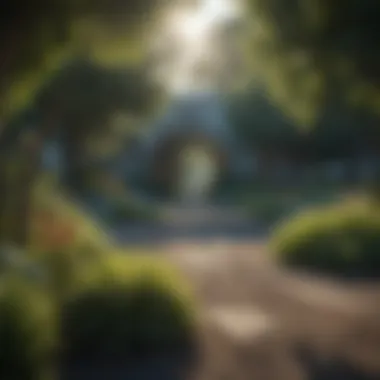

Soil Management Strategies
Soil health is vital for the success of any landscaping project. Good soil management strategies can improve soil quality and promote plant growth. Testing the soil helps identify its nutrient levels and pH. Based on this information, amendments can be applied to optimize conditions for plants.
Using organic matter such as compost enhances soil structure and fertility. This practice also encourages beneficial microorganisms, which contribute to a healthy ecosystem. Cover cropping is another beneficial technique. It protects the soil from erosion, improves its structure, and adds nutrients back into the soil when the crops are tilled under.
Biodiversity Promotion
Promoting biodiversity is an integral part of sustainable blue ring landscaping. A diverse range of plants not only enhances aesthetic value but also supports local wildlife, including pollinators and insects. Choosing a mix of native and adapted plants encourages a resilient ecosystem. These plants are typically more resistant to local pests and diseases.
Creating habitats such as birdhouses, bee hotels, and water features can attract various species. Furthermore, establishing buffer zones with native plants along water bodies helps filter pollutants and provides crucial habitats for wildlife.
In summary, sustainable practices in blue ring landscaping play a significant role. These practices contribute to conserving resources, improving soil health, and increasing biodiversity, all of which are essential for a thriving landscape.
Maintenance of Blue Ring Landscapes
Maintenance is crucial for the longevity and aesthetic appeal of blue ring landscapes. Regular upkeep ensures that the designed space continues to thrive, reflecting the foundational principles of beauty and sustainability. This section addresses the key aspects of maintenance, highlighting various strategies that landscapers and enthusiasts can employ to keep their blue ring landscapes flourishing.
Routine Care and Upkeep
Routine care forms the backbone of landscape maintenance. This includes tasks such as watering, fertilizing, pruning, and mulching. Each task is essential to ensure plants are healthy and vibrant.
- Watering: Blue ring landscapes benefit from a consistent watering schedule, especially during dry seasons. This promotes deep root growth, enhancing plant resilience.
- Fertilizing: Using organic fertilizer can improve soil quality, encouraging plant health. Timing should align with the growing season for maximum impact.
- Pruning: Regular trimming of dead or overgrown branches not only maintains visual appeal but also prevents diseases from spreading.
- Mulching: Applying a layer of mulch reduces weed growth and retains moisture in the soil, supporting consistent plant health.
This routine should be adapted based on the specific needs of the plant species and local climate conditions.
Pest and Disease Management
Managing pests and diseases is vital for maintaining the integrity of blue ring landscapes. Early detection and intervention can save plants from significant damage.
Some methods of managing these threats include:
- Monitoring: Regularly inspect plants for signs of pests, such as aphids or spider mites. Look for distinctive changes in foliage color or texture.
- Natural Remedies: Introduce beneficial insects like ladybugs that feed on harmful pests. This promotes a balanced ecosystem without the need for pesticides.
- Crop Rotation: Changing plant varieties in specific areas can disrupt pest life cycles, reducing infestations.
- Sanitation Practices: Remove infected plants immediately to prevent the spread of disease. Clean tools after use to avoid cross-contamination.
Taking these management strategies seriously can help sustain the health and vibrancy of blue ring landscapes.
Seasonal Adjustments
Understanding seasonal changes is vital for effective landscape maintenance. Each season presents unique challenges and opportunities for care.
- Spring: This is the prime time for planting and rejuvenation. Regular watering and the introduction of fertilizers can stimulate new growth.
- Summer: Focus on watering deeply during heat periods. Ensure that mulch is replenished to combat evaporation.
- Fall: Prepare for cooler weather by cutting back perennials and protecting young plants with mulch.
- Winter: Implement protective measures such as burlap wraps for sensitive plants. Limit watering as dormant periods approach.
"Landscape maintenance is not just about plants, it’s about preserving the vision and purpose behind a blue ring landscape."
Engaging local communities in these maintenance efforts can also enhance the experience, fostering a sense of ownership and shared responsibility.
Case Studies of Blue Ring Landscaping
Case studies in blue ring landscaping provide invaluable insights into how theories and practices translate into real-world scenarios. They illustrate both successful implementations and obstacles faced during projects. Understanding these experiences enriches the knowledge base of both practitioners and enthusiasts. It emphasizes the practical aspects of blue ring landscaping, showcasing its adaptability and benefits in diverse environments.
Successful Implementations
Successful examples of blue ring landscaping demonstrate practical and aesthetic innovations. One notable case is the landscape of the San Francisco Botanical Garden. Here, designers integrated various blue ring concepts to create a tranquil space that fosters biodiversity. This project emphasizes native plant species, promoting a sense of place and ecological harmony.
The layout encourages visitors to explore its winding pathways, mirroring the fluid dynamics of water. This design demonstrates how blue ring landscaping can promote positive ecological relationships while maintaining visual appeal.
Another example is the blue ring landscaping seen in the redevelopment of urban parks in Portland, Oregon. Here, urban planners used blue ring principles to enhance water management. By integrating ponds and rain gardens, they effectively dealt with stormwater runoff while providing aesthetic elements to the park. The blend of functional design with visual elements is a key takeaway from this case, showing that beauty and utility can coexist in blue ring landscapes.
Lessons Learned from Challenges
While case studies showcase successes, they also reveal challenges. One frequent issue is resistance to change among local communities. For example, a project at the University of California, Riverside faced initial backlash. Students and faculty were hesitant to shift from traditional landscaping approaches. The administration learned to involve community insights early in the planning process, improving acceptance and engagement.
Moreover, maintaining biodiversity posed challenges in the blue ring landscaping initiative in Toronto's waterfront development. The introduction of non-native species led to unexpected ecological disruptions. As a result, project managers realized the importance of thorough research and planning. Evaluating environmental impacts before implementing changes is crucial, ensuring that new landscapes function well with existing ecosystems.
The Role of Technology in Blue Ring Landscaping
Technology plays a crucial role in modern landscaping practices, especially in blue ring landscaping, where efficiency and sustainability are paramount. It encompasses a wide range of tools and systems that enhance design, plant health, and environmental conservation. By integrating technology, landscapers and gardening enthusiasts can create more effective and efficient landscapes. This section will explore the specific elements that involve technology and their respective benefits in blue ring landscaping.
Design Software and Tools
Design software has revolutionized the way landscapes are planned and executed. These digital tools allow landscapers to visualize the final outcome before any physical work begins. Programs like SketchUp or AutoCAD provide users with the ability to create accurate, three-dimensional representations of their projects. Additionally, user-friendly apps empower amateur gardeners to experiment with design ideas too.
Using design software, landscapers can consider factors such as sunlight, wind patterns, and soil type in their plans. This leads to more thoughtful arrangements of plants and features that complement each other.
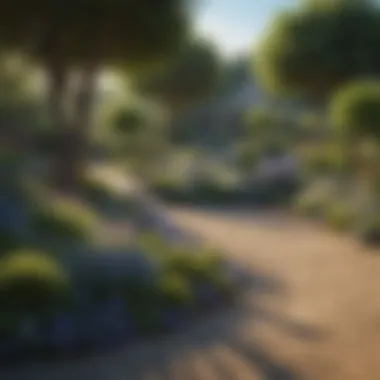

Some benefits of utilizing design software in blue ring landscaping include:
- Improved Planning: Landscaping becomes more structured, reducing wasted materials and labor.
- Virtual Testing: Landowners can visualize how plants will mature over time, leading to better decision-making regarding plant selection.
- Collaboration: Design software facilitates easier communication between clients and landscapers, ensuring everyone is on the same page regarding expectations.
Automated Irrigation Systems
Automated irrigation systems are essential in maintaining blue ring landscapes efficiently. These systems are designed to deliver precise amounts of water to plants, minimizing waste and ensuring optimal growth conditions. Advanced technology, such as drip irrigation or smart controllers, can adjust the water output based on weather conditions and soil moisture, making maintenance much simpler.
The advantages of automated irrigation include:
- Water Conservation: By delivering water directly to the root zone, there is less evaporation or runoff. This is particularly important in areas facing water scarcity.
- Time Saving: With these systems in place, gardeners and farmers can save time that would have been spent on manual watering. This allows them to focus on other aspects of landscape management.
- Consistent Plant Care: Automated systems ensure that plants receive consistent moisture, which leads to healthier growth.
"Investing in technology is not just about convenience; it is about creating a sustainable future for landscaping."
Community Engagement in Blue Ring Landscaping Projects
Community engagement is a vital aspect of blue ring landscaping projects. It involves the collaboration and input of community members in the planning, design, and maintenance phases of landscaping initiatives. Engaging the community fosters a sense of ownership and promotes sustainable practices. It also ensures that the landscapes created are not only aesthetically pleasing but also relevant and useful to the people living in the area.
The benefits of community engagement are significant. First, it enhances the overall effectiveness of landscaping projects. When local stakeholders are involved, their unique insights and needs can shape the design process. This leads to landscapes that reflect the community’s identity and values. Furthermore, involving local stakeholders can lead to increased funding and resources, as community members are more likely to support initiatives they had a role in shaping.
Moreover, community engagement promotes educational opportunities. When residents are actively involved, they become more informed about the environmental benefits and maintenance requirements of blue ring landscaping. This can lead to increased sustainability as the community learns to care for their shared spaces. It is essential to consider various strategies for effective engagement.
Involving Local Stakeholders
Involving local stakeholders is crucial in the initial stages of any landscaping project. Stakeholders can include residents, local businesses, schools, and environmental groups. By gathering input from these groups, landscape designers can create spaces that serve multiple purposes.
This involvement can take several forms:
- Surveys and Feedback Sessions: These provide a platform for community members to voice their opinions on proposed designs.
- Planning Meetings: Gathering stakeholders in collaborative meetings can foster dialogue and generate innovative ideas.
- Focus Groups: These smaller groups allow for in-depth discussions on specific features of the landscape.
Integrating local stakeholders into the landscaping process ensures that their needs and desires are prioritized. It strengthens community ties and creates a sense of responsibility for the landscape’s upkeep and sustainability.
Educational Workshops and Outreach
Educational workshops and outreach programs are effective methods for enhancing community engagement in blue ring landscaping. These initiatives aim to inform and empower residents about the principles of landscaping, maintenance, and ecological benefits.
Such workshops can cover various topics:
- Native Plant Benefits: Educating the community about local plant species, their ecological roles, and how to incorporate them into landscapes.
- Sustainable Practices: Teaching techniques for water conservation, soil health, and pest management, which can be easily implemented in the community.
- Landscape Design Skills: Offering basic design workshops can inspire residents to contribute ideas or even take on small projects in their yards or local parks.
Overall, these outreach programs not only inform but also create a network of knowledgeable individuals who can contribute to the long-term success of blue ring landscaping projects.
Through community engagement, blue ring landscapes become living examples of collaboration, education, and sustainability. This participatory approach enhances the social fabric of neighborhoods while promoting environmental responsibility.
Future Trends in Blue Ring Landscaping
The landscape design field continuously evolves, influenced by societal shifts and environmental dynamics. In blue ring landscaping, understanding future trends is crucial for sustaining its relevance and effectiveness. By embracing innovative practices and adaptive techniques, both professionals and enthusiasts can optimize their landscapes. The focus will not just lie on aesthetics, but also on resilience and ecological balance.
Innovations in Design and Planting
Recent developments in design technology and planting techniques are reshaping how blue ring landscapes are conceptualized. One significant innovation is the integration of smart technology in design software. Programs like SketchUp and AutoCAD now include features tailored for landscape planning, offering improved modeling capabilities. This allows landscape designers to visualize their projects more effectively, ensuring that every element aligns with the desired outcome.
Additionally, there is a growing emphasis on using technology for plant growth monitoring. Soil sensors and smart irrigation systems ensure plants receive the right amount of moisture, promoting health and sustainability. By utilizing species that provide ecological benefits, designers can create symbiotic relationships between plants, insects, and animals. This approach supports biodiversity, which is increasingly recognized as essential for healthy ecosystems.
Adapting to Climate Change
As climate change intensifies, adapting landscaping practices becomes indispensable. Blue ring landscaping must be proactive in addressing climate impacts through resilient design choices and plant selections. It is essential to choose plants that thrive in altered conditions, such as drought-resistant varieties. These adaptations not only help landscapes survive harsh conditions but also minimize maintenance needs.
Moreover, water management strategies are evolving to counteract climate-related challenges. Techniques such as rain gardens and permeable pavements foster water absorption, reducing runoff and erosion. As a result, landscapes not only sustain themselves but also contribute positively to the surrounding environment.
"Adaptation in landscaping is not just a trend; it's a necessity for future resilience."
Consider these upcoming changes while planning future projects to ensure their success and longevity.
Epilogue
The conclusion serves as a vital component in any comprehensive exploration of blue ring landscaping, summarizing critical elements while emphasizing significance. It allows readers to take away the core principles that have been discussed throughout the article, consolidating knowledge in a concise manner.
Summary of Key Points
In summary, blue ring landscaping merges sustainability with aesthetics. Key points include:
- Principles of design: Focusing on color theory, spatial organization, and natural elements enhances overall appeal.
- Plant selection: Choosing the right plants is crucial, taking into account both native and non-native species.
- Sustainable practices: Implementing water conservation, soil management, and biodiversity promotion creates a healthy environment for the ecosystem.
- Maintenance strategies: Regular upkeep, pest management, and seasonal adjustments ensure the longevity and beauty of the landscape.
- Community engagement: Involving local stakeholders and conducting educational workshops fosters appreciation and understanding of blue ring landscaping.
Final Thoughts on Blue Ring Landscaping
Considering future trends, blue ring landscaping is adaptable. As climate challenges arise, it becomes imperative to innovate design and planting methods. This malleability allows blue ring landscaping to remain relevant and beneficial, addressing ecological needs and visual desires. The discipline stands as a testament to the fusion of practicality and artistry in outdoor spaces. As both enthusiasts and professionals engage with these principles, they contribute significantly to creating environments that are not only visually stunning but also ecologically sound.
"Landscaping is not merely an art; it is a commitment to nurture the environment for future generations."














